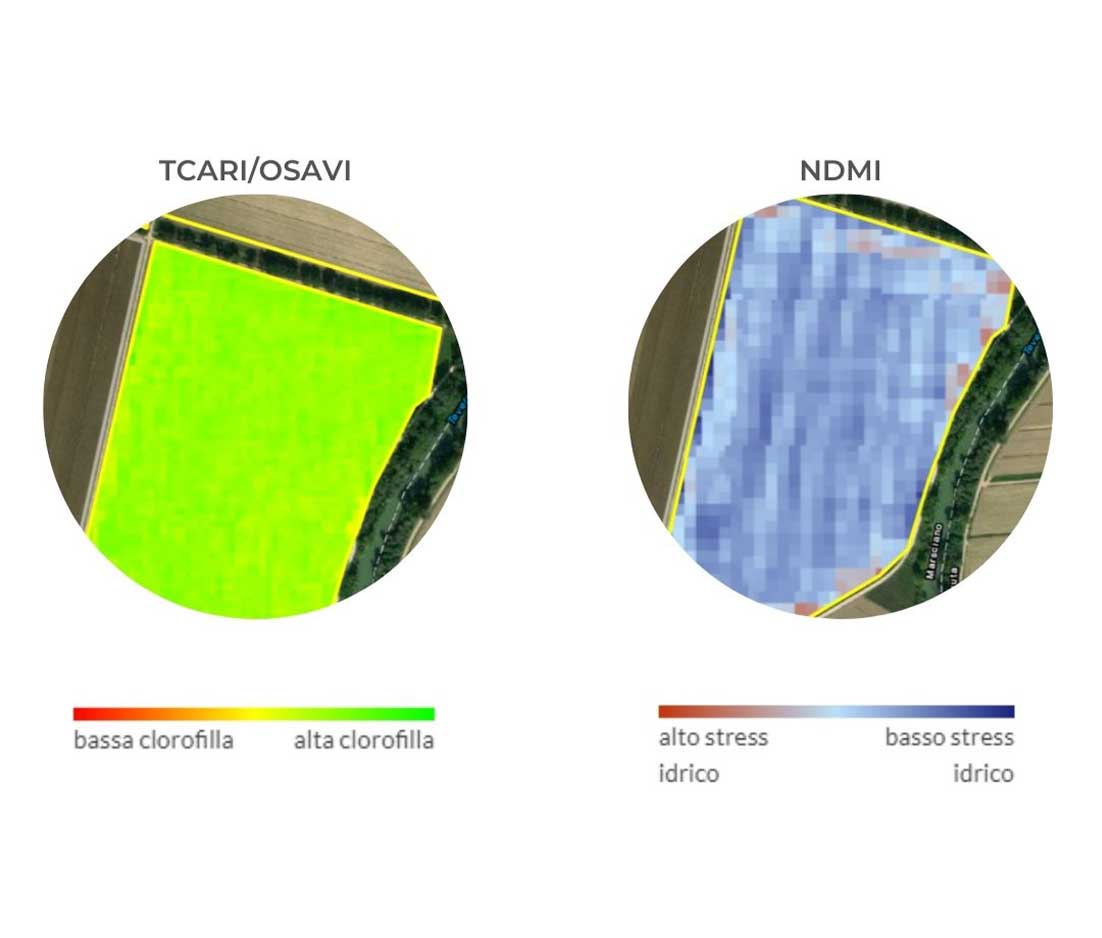Satellite imagery
Satellites are one of the most used means in agriculture to perform remote sensing. The satellite imagery in fact allows to monitor crops remotely in a precise and efficient way.

Spatial and temporal resolution of satellites
There are many satellites that acquire multispectral images from space: the most common are Sentinel-2 and Landsat 8 (both used in Agricolus platform), Airbus Spot 6 and Pléiades (under testing).
The images obtained have a different spatial resolution: Landsat 8 provides data with a spatial resolution of 30 m, while Sentinel-2 of 10, Spot 6 up to 1.5 meters and Pléiades up to 50 cm.
The temporal resolution for Landsat 8 is every 16 days, while for Sentinel-2 every 3/5 days (depending on the areas). Airbus Spot 6 and Pléiades can instead be requested depending on the needs.
The regular passage of the satellites determines the availability of the data in several phases of the growing season, but it is also important to underline that during the satellite transit, where the area under examination is covered by clouds, the data is not usable.
Data processing
Thanks to a sophisticated proprietary technological structure, Agricolus is able to manage different services and elaborate satellite images autonomously.
Through the Copernicus Open Access Hub portal, Agricolus has access to Sentinel-2 satellite data and integrates it to provide vegetation indices to end users. The integration of satellite images occurs through the DIAS (Copernicus Data and Information Access Service) service of the ONDA consortium, wanted by the European Commission, and ESA.

The satellite images are then cropped on the field boundaries with the support of L3Harris Geospatial technologies.
Finally, the Sentinel-2 bands are processed by Agricolus to calculate the multiple indices of vigor, water stress and chlorophyll. The indices are provided for all available dates, automatically excluding images with cloud cover.
Vegetation indices obtained from satellite
When talking about satellite images, and remote sensing in general, it is necessary to introduce the concept of vegetation index to understand how they allow the monitoring of the health of crops without the need to go to the field.
Vegetation indexes are a key tool of Smart Farming: the use of satellite data and their correct interpretation reduce the interventions in the field and make sustainable, from the economic point of view, a structured crop scouting activity.
The indices can describe the vigor of the plant, providing a measure of its general health, or specific problems such as water stress or the amount of chlorophyll.


Types of vegetation indices
NDVI: it allows to evaluate the health of the vegetation, analyzing the reflectance of the vegetation in the Red and NIR bands.
SAVI: allows to evaluate the conditions of vegetation development in the emergency and early stages of development, as it applies a correction to bare soil.
LAI: leaf area index that estimates the leaf area of the plant expressed in m2 on m2.

TCARI/OSAVI: specific index that allows to identify chlorotic areas within the field.
WDRVI: it analyzes the health of the vegetation and is particularly useful when the vegetation is well developed and lush and the other vegetation indices tend to saturate.
GNDVI (Green-NDVI): it provides an indication of the health of the vegetation and reduces the saturation effect when the vegetation is particularly developed.
NDMI: specific index that evaluates the water content of the vegetation, therefore usable only with developed vegetation.
NMDI: can be used to assess the water content of the soil; in case of bare soil, a high index value indicates dry soil. In the presence of vegetation, a high index value indicates that the plant is not under water stress.

Historical and comparative data
In agriculture it is essential to monitor and compare crop development on different plots and during different years.
The four main steps for the interpretation of vegetation indices are in fact the multi-temporal analysis and the comparison between indices: 1) the assessment of the phenological stage of the plant; 2) the analysis of the historical trend of indices to assess whether there are anomalies and whether they are related to known phenomena; 3) the identification of indices to be compared; 4) the comparison between indices to identify critical areas to be verified in the field.
The comparison of satellite images allows us to evaluate the relationships between different indices (such as low vigor and high water stress) and the possible causes of their variations.
The graph of the historical trend of vegetation indices also allows to keep track of what happens in the field and to evaluate the changes compared to the data of previous years.



